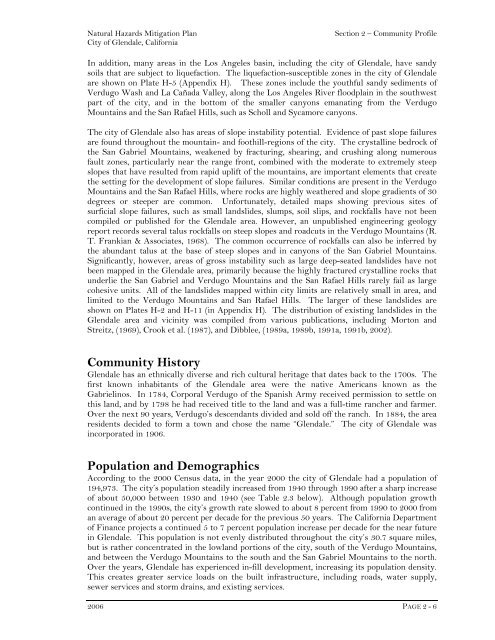Glendale (PDF) - Hazard Mitigation Web Portal - State of California
Glendale (PDF) - Hazard Mitigation Web Portal - State of California
Glendale (PDF) - Hazard Mitigation Web Portal - State of California
- No tags were found...
You also want an ePaper? Increase the reach of your titles
YUMPU automatically turns print PDFs into web optimized ePapers that Google loves.
Natural <strong>Hazard</strong>s <strong>Mitigation</strong> PlanCity <strong>of</strong> <strong>Glendale</strong>, <strong>California</strong>Section 2 – Community Pr<strong>of</strong>ileIn addition, many areas in the Los Angeles basin, including the city <strong>of</strong> <strong>Glendale</strong>, have sandysoils that are subject to liquefaction. The liquefaction-susceptible zones in the city <strong>of</strong> <strong>Glendale</strong>are shown on Plate H-5 (Appendix H). These zones include the youthful sandy sediments <strong>of</strong>Verdugo Wash and La Cañada Valley, along the Los Angeles River floodplain in the southwestpart <strong>of</strong> the city, and in the bottom <strong>of</strong> the smaller canyons emanating from the VerdugoMountains and the San Rafael Hills, such as Scholl and Sycamore canyons.The city <strong>of</strong> <strong>Glendale</strong> also has areas <strong>of</strong> slope instability potential. Evidence <strong>of</strong> past slope failuresare found throughout the mountain- and foothill-regions <strong>of</strong> the city. The crystalline bedrock <strong>of</strong>the San Gabriel Mountains, weakened by fracturing, shearing, and crushing along numerousfault zones, particularly near the range front, combined with the moderate to extremely steepslopes that have resulted from rapid uplift <strong>of</strong> the mountains, are important elements that createthe setting for the development <strong>of</strong> slope failures. Similar conditions are present in the VerdugoMountains and the San Rafael Hills, where rocks are highly weathered and slope gradients <strong>of</strong> 30degrees or steeper are common. Unfortunately, detailed maps showing previous sites <strong>of</strong>surficial slope failures, such as small landslides, slumps, soil slips, and rockfalls have not beencompiled or published for the <strong>Glendale</strong> area. However, an unpublished engineering geologyreport records several talus rockfalls on steep slopes and roadcuts in the Verdugo Mountains (R.T. Frankian & Associates, 1968). The common occurrence <strong>of</strong> rockfalls can also be inferred bythe abundant talus at the base <strong>of</strong> steep slopes and in canyons <strong>of</strong> the San Gabriel Mountains.Significantly, however, areas <strong>of</strong> gross instability such as large deep-seated landslides have notbeen mapped in the <strong>Glendale</strong> area, primarily because the highly fractured crystalline rocks thatunderlie the San Gabriel and Verdugo Mountains and the San Rafael Hills rarely fail as largecohesive units. All <strong>of</strong> the landslides mapped within city limits are relatively small in area, andlimited to the Verdugo Mountains and San Rafael Hills. The larger <strong>of</strong> these landslides areshown on Plates H-2 and H-11 (in Appendix H). The distribution <strong>of</strong> existing landslides in the<strong>Glendale</strong> area and vicinity was compiled from various publications, including Morton andStreitz, (1969), Crook et al. (1987), and Dibblee, (1989a, 1989b, 1991a, 1991b, 2002).Community History<strong>Glendale</strong> has an ethnically diverse and rich cultural heritage that dates back to the 1700s. Thefirst known inhabitants <strong>of</strong> the <strong>Glendale</strong> area were the native Americans known as theGabrielinos. In 1784, Corporal Verdugo <strong>of</strong> the Spanish Army received permission to settle onthis land, and by 1798 he had received title to the land and was a full-time rancher and farmer.Over the next 90 years, Verdugo’s descendants divided and sold <strong>of</strong>f the ranch. In 1884, the arearesidents decided to form a town and chose the name “<strong>Glendale</strong>.” The city <strong>of</strong> <strong>Glendale</strong> wasincorporated in 1906.Population and DemographicsAccording to the 2000 Census data, in the year 2000 the city <strong>of</strong> <strong>Glendale</strong> had a population <strong>of</strong>194,973. The city’s population steadily increased from 1940 through 1990 after a sharp increase<strong>of</strong> about 50,000 between 1930 and 1940 (see Table 2.3 below). Although population growthcontinued in the 1990s, the city’s growth rate slowed to about 8 percent from 1990 to 2000 froman average <strong>of</strong> about 20 percent per decade for the previous 50 years. The <strong>California</strong> Department<strong>of</strong> Finance projects a continued 5 to 7 percent population increase per decade for the near futurein <strong>Glendale</strong>. This population is not evenly distributed throughout the city’s 30.7 square miles,but is rather concentrated in the lowland portions <strong>of</strong> the city, south <strong>of</strong> the Verdugo Mountains,and between the Verdugo Mountains to the south and the San Gabriel Mountains to the north.Over the years, <strong>Glendale</strong> has experienced in-fill development, increasing its population density.This creates greater service loads on the built infrastructure, including roads, water supply,sewer services and storm drains, and existing services.2006 PAGE 2 - 6
















